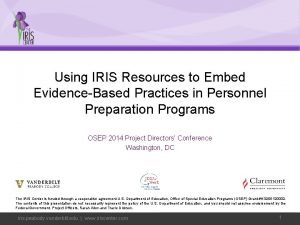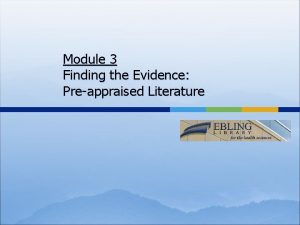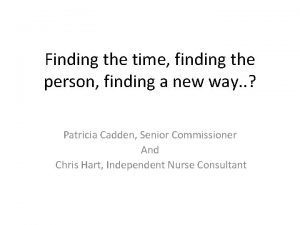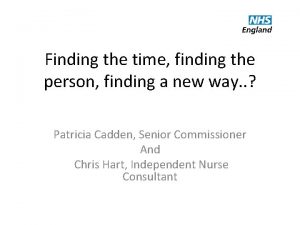Module 3 Finding the Evidence Preappraised Literature Evidence






















- Slides: 22

Module 3 Finding the Evidence: Pre-appraised Literature

Evidence hierarchy Level of evidence Meta analyses Systematic reviews EBM Literature: Reviews Randomized control trials (RCTs) Controlled trials w/o randomization Individual Studies: Experimental Cohort studies Case control studies/retrospective cohort Case studies/qualitative studies Individual Studies: Observational

Review literature Systematic reviews • Address a single clinical question • Locate and validate all trials/studies relevant to the • • question (inclusion and exclusion criteria) Should include an explicit literature search Draw a conclusion, if possible, based on multiple studies Meta-analyses • Systematic reviews taken 1 step further • Look for studies where the data can be combined large • study End product is often displayed in a graphical format (forest plot)

Growth of reviews 15, 000 # published per year 12, 500 10, 000 7500 5000 2500 1990 1995 2000 2005 2010

Finding worthy reviews

DARE (CRD) commentary for: Gaster B, Holroyd J. St John's Wort for depression: a systematic review. Archives of Internal Medicine 2000; 160(2): 152 -156

Finding worthy reviews

ACP Journal Club

Finding worthy reviews

Clinical Evidence

Finding any reviews

Appraising reviews Focus Specific Questions Question Is the specific purpose of the review stated? Is the review question clearly and explicitly stated? Literature Search Were comprehensive search methods used to locate studies? Was a thorough search conducted using appropriate databases? Were other potentially important sources explored? Study Selection What types of studies are reviewed? Are they the same type? How many participants in the review? Critical Appraisal Was the validity of included studies assessed? Are the validity criteria reported? Are the inclusion criteria reported? Similarity of Groups & Treatments Are treatments similar enough to combine? Were reasons for any differences between individual studies explored? Data Synthesis Were findings from individual studies combined appropriately? Are the methods used to combine studies reported? Are the results consistent across studies?

An example Linde K, et al. 2005. St John's wort for depression: meta-analysis of randomised controlled trials. British Journal of Psychiatry 186: 99 -107








Keep in mind Still many interventions not covered by SRs • The Cochrane Database is good example of this: approximately 10 -15, 000 Cochrane reviews are needed to cover interventions that have been investigated in clinical trials. After 18 years <50% have been published (completion is est. ~30 years). Need constant upkeep • Half will need to be updated each year • Most take 6 -12 months to be developed and published

Module 3 Finding the Evidence: Pre-appraised Literature
 Preapprized
Preapprized Finding answer through data collection
Finding answer through data collection Thematic ideas
Thematic ideas Finding themes in literature
Finding themes in literature C device module module 1
C device module module 1 Iris module evidence-based practices answers
Iris module evidence-based practices answers Hát kết hợp bộ gõ cơ thể
Hát kết hợp bộ gõ cơ thể Frameset trong html5
Frameset trong html5 Bổ thể
Bổ thể Tỉ lệ cơ thể trẻ em
Tỉ lệ cơ thể trẻ em Voi kéo gỗ như thế nào
Voi kéo gỗ như thế nào Tư thế worm breton
Tư thế worm breton Chúa yêu trần thế alleluia
Chúa yêu trần thế alleluia Các môn thể thao bắt đầu bằng tiếng chạy
Các môn thể thao bắt đầu bằng tiếng chạy Thế nào là hệ số cao nhất
Thế nào là hệ số cao nhất Các châu lục và đại dương trên thế giới
Các châu lục và đại dương trên thế giới Công thức tiính động năng
Công thức tiính động năng Trời xanh đây là của chúng ta thể thơ
Trời xanh đây là của chúng ta thể thơ Mật thư tọa độ 5x5
Mật thư tọa độ 5x5 101012 bằng
101012 bằng độ dài liên kết
độ dài liên kết Các châu lục và đại dương trên thế giới
Các châu lục và đại dương trên thế giới Thơ thất ngôn tứ tuyệt đường luật
Thơ thất ngôn tứ tuyệt đường luật











































